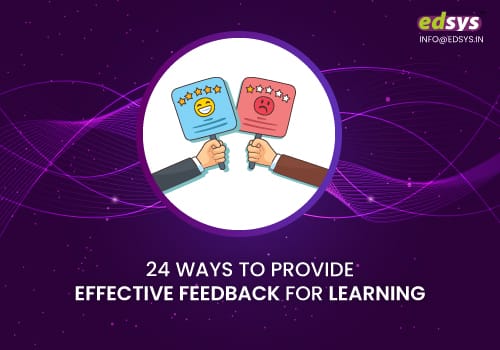Feedback is an information, advise, praise or evaluation given to a student, by the teacher, about his or her performance for his learning outcomes. It helps the student to enhance his performance and achievement.
Giving proper feedback to a student is one of the greatest challenges that you, as a teacher may face. In fact, effective feedback can double the effect of classroom input on a student’s achievement. Therefore, it is an important part of good teaching.
Get Best Free Art Learning Apps (Check it Now)
Some of the effective feedback for learning are listed below:
1) Establish a Respectful Learning Environment
Every individual in the classroom should be respected and treated with dignity and civility irrespective of their class, race, mental or physical abilities. You should ensure that a student never feels offended while giving the feedback; as, such comments may negatively impact the students.
2) Feedback should be given soon after the Learning
If you wait for a long period to give a feedback, then, the moment would be lost and the student may not get a relation for the feedback and the action. So, try to deliver the feedback on time.
3) Ask these 4 Questions
Student psychology says that, every learner will always be keen to know about where he stands with regard to the work he did. So, you can ask these 4 questions before giving the feedback:
- What are the capabilities of the student?
- What are his/her weaknesses?
- How good or bad is the student’s work when compared with others?
- What are the effective ways for him/her to improve?
4) Use a Notebook to keep a track of the Student’s Progress:
Jotting down comments on a daily or a weekly basis will help you to analyze about the student’s learning process. This may include a record of the good questions one has asked, his behavioral issues, areas of improvement, test scores etc.
5) Maintain the 3C’s of giving an Effective Feedback
Using the concept of 3C’s will help the student to take the comments positively. The 3C’s are:
- Compliment
- Correct
- Compliment
That is, every time you give a feedback, it should be followed and preceded by a compliment; which will enable the student to take everything positively.
6) Feedback should be Descriptive rather than Evaluative
Giving a detailed explanation of what the student has done rightly and wrongly is one of the most effective ways of rendering a feedback for learning. It would be more productive if you focus more on the rights and then analyze it by citing examples.
7) Be Sensitive to the Individual needs of the Student
A classroom is a group of diverse students. Every student may have different attitudes of mind. So, individual attention should be given to each student while giving feedback. Try to maintain a balance between providing proper encouragement and wanting not to hurt the individual feeling of the student.
8) Feedback must be given by referring to a Skill or an Ability:
Pointing out the right skills of a student will provide him more confidence in using his abilities. Apart from pointing the skills, you can also compliment for a performance, which may give him a kind of self-realization of his works.
9) Host a one-to-one Conference:
An optimistic one-to-one feedback session will draw student’s attention as well as, will give him an opportunity to clear his queries without hesitation. As this strategy requires time management, you will have to ensure that the other students are busy with their work while you meet the student.
10) Allow the Students to take Notes
While in a meeting with a student, inculcate the ‘habit of making notes’ as it will help him recollect his right and wrong responses respectively.
11) Distribute the Answer Sheets or Comment Cards at the Beginning of the Session
You can give out the corrected sheets or the comment cards at the beginning of the class. It will let the students to clear their doubts during the class hour itself, which will make a platform for the relevant discussion of the queries.
12) Provide a Model or an Example
While giving feedback about the do’s and don’ts , you better try to explain it by citing an example of how an A+ paper looks like when compared to a C+ paper which will help the student to understand more about the insufficiency in his answer paper.
13) Invite Students to Give Feedback
This strategy will be useful to you as well as your students, as the students will get an opportunity to express their views about the class and you will learn few things about yourself.
14) Give Genuine Praise
In order to encourage the students, never give them pseudo-praises, rather give them genuine praises, that too only when they really deserve it. If you give a “Good” or “Keep it up” on all his works, then after a period of time, it will become meaningless to him. So, you can try to offer genuine praises.
15) Use Phrases like “I noticed”
Making use of phrases like ‘I noticed…’ have multiple benefits on the students, as it will make the student aware of the fact that he is being noticed by you, which will not make him lethargic for his tasks. Thus, acknowledging a student’s effort will positively influence his academic performance.
16) Ask Another Adult to Give Feedback
Inviting a ‘guest’ or ‘another adult’ to grade the students will increase the quality of the work of a student. This will encourage the students as they will get an external hand of appreciation.
17) Use Post-It Notes:
Many students feel humiliated when commented publicly, this can be resorted by using ‘post-it notes’, where you can write a comment on his note book, rather than telling it aloud. This is really effective for students who are short-tempered.
18) Use Different Forms of Feedback:
Verbal, non-verbal or written forms are different ways of giving a feedback. Apart from telling the feedback aloud or writing in notebooks, you can use gestures and facial expressions like ‘frowns’ or ‘thumb ups’ as means of appreciation.
19) Focus on One of the Required Skills:
This can be explained with an example, for instance; if you tell the students, that for the next day’s exam, you are going to focus only on the ‘grammar’ part, then it would be easier for the students to learn it. This strategy will not give a steady growth, but a gradual improvement can be traced in students, without any burden for them.
20) Fix Due Dates for Students:
In this strategy, you can club the students, and assign a day for a meet. Rotational charts can be used so that the student will also know about his turn to meet you, thereby using the time fruitfully to discuss doubts.
21) Encourage Self-Feedback:
You can give opportunities to the students to evaluate themselves, i.e., give them a space to correct their own worksheets and rate themselves. This will help them to analyze their self. This strategy can only be done with older students.
22) Give a Tangible and Transparent feedback:
To make the student more attentive while giving a feedback you can make use of simple and understandable words. Avoid beating about the bush, which may drag the student’s attention.
23) Never Postpone the Feedback Session
To make the feedback more effective, you should be consistent about it. Allot a particular time in the class for feedbacks, rather than using the age-old cliché dialogues of a teacher that “Since we are running out of time, we’ll discuss it later”.
24) Try to be a Friendly Teacher
No matter how strict you are in class, be friendly during the feedback session, so that the student may not have a sense of aversion to you.
Get Best Free Art Learning Apps (Check it Now)
The greatest difficulty that the teacher may face while giving a feedback is the arrogance of her students.
Reading through these 24 Ways to Provide Effective Feedback for learning might give out an idea that it’s tedious to practice. But without feedback, the entire learning process becomes so ineffective and pointless. Be it positive or negative, presenting feedback is an art and the effect that it will have on the students is absolutely miraculous.



